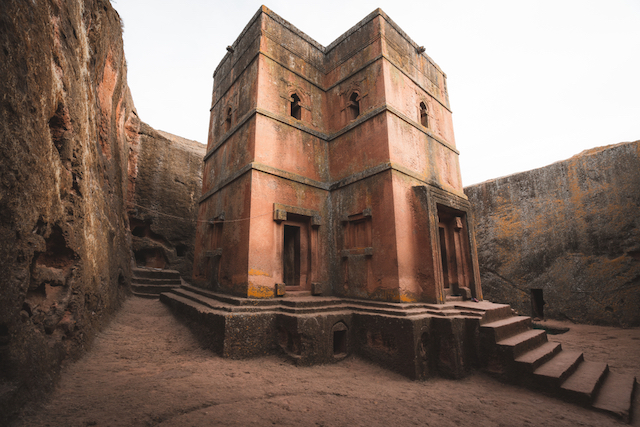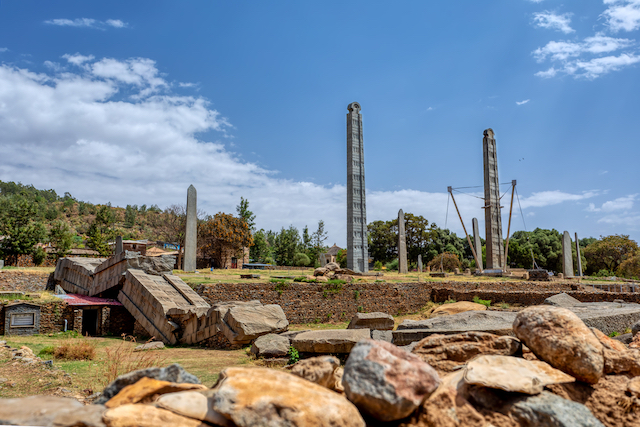


The rock-hewn churches of Lalibela are one of Ethiopia's national wonders. This site is located in Ethiopia's Christian Holy city, featuring many ancient churches carefully carved into the rock of the Northern Ethiopian landscape. This UNESCO Heritage site is hugely popular amongst many tourists and locals. There are a total of 11 monolithic churches around the Lalibela historic site and are grouped in 3 separate locations: the Northern group, the Western group, and the Eastern group. This site is known to have a great influence on Christianity in Ethiopia to this day. It's also home to a large community of priests and draws many pilgrims to celebrate several of the special feasts on the Ethiopian Christian calendar. All of the Rock-Hewn Churches of Lalibela are preserved in their natural settings to this day. Some of the churches of Lalibela even date back to the 7th century, and the area still demonstrates evidence of the ancient village layout. The churches have also taken inspiration from several Christian symbols, including the Virgin Mary, the 12 apostles, and the many saints of the faith.
Axum towers date back to the days of the Axumite Empire. This empire had merchants coming from all corners of the red sea to trade goods. Instead of building pyramids like neighboring countries Egypt and Sudan, Axum built massive towers. The towers started appearing around the 3rd and 4th centuries. Historians assume that the towers represented something like tombs. The taller the tower is, the more prestigious and elite the person was, and the more sophisticated the carvings get. The towers were called Stelae. The stelae were built from weather-resistant rocks called nepheline syenite. The towers range anywhere from 3 feet tall to be as tall as 100 feet. It was made of stone, and most of them have been destroyed during different battles fought in the region. The largest tower ( over 100 feet tall) was destroyed by the Italians when they came to invade Ethiopia in the early 1900s. Axum still tried to preserve the fallen tower by placing its broken pieces together on the grounds of where it was built.


The Ethiopian Orthodox Christians believe that the ark of the covenant is located in the City of Axum in Northern Ethiopia ( Tigray region). It is believed that the arc was brought to Ethiopia by Menelik 1. Christians believe the arc contains the ten commandments written on two stones. There are different stories of how the arc made it to Axum. Some believe it stayed in Egypt before arriving here, while other historians proved that it stayed in different cities in Ethiopia before finally coming to Axum. Every Ethiopian Orthodox church has a replica of the arc inside the church. During the Timket celebration ( the day Jesus was baptized), the arc leaves the church guarded and surrounded by each church's head priest and is celebrated with visitors singing and chanting around it. The arc is later returned to its designated church. The possessions of the arc have never been revealed to the public. It is preserved and guarded near the church of our Lady Mary of Tsion.
Blue Nile Falls, locally also known as "Tis Abay," meaning great smoke, is a waterfall on the Blue Nile River of Ethiopia. It is also one of the two tributaries that make up the River Nile, the longest river in Africa. The waterfall is usually the biggest during the wet season as the downpours are heavier during the rainy season. Along with the river, there are plenty of other reasons the Blue Nile Falls is worth a visit. Firstly, the area is surrounded by a variety of wildlife, including monkeys and plenty of bright-colored birds. The path on the way to the falls is also home to some small villages, which give an insight into the village life and Ethiopian culture. Moreover, the area is surrounded by lots of splendid sceneries, from the stunning nature to the beautiful rainbows and plumes of mist created as the water crashes down, making it a perfect setting for exceptional photographic opportunities.
